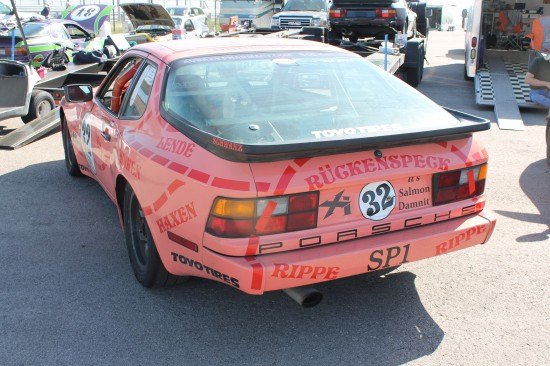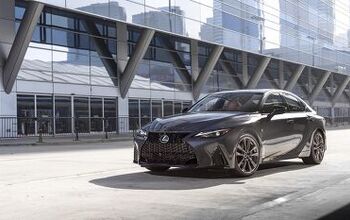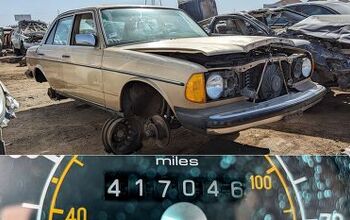How to Buy a LeMon (The Fun Kind)

People write buyers’ guides for fancy newfangled machinery all the time, but what if you’re looking for a hooptie to go racin’ with? Lower your expectations and enter the world of triple-digit-price-tag motoring.
Most grassroots racers don’t have purpose-built factory racecars or pristine concours-style restorations. They’ve picked up a cheap car that they don’t mind ripping the interior bits out of so they can go play. To be honest, if a car is too nice, I’d feel bad about turning it into a racecar or running it to the limits of its mechanical ability, anyway. A walk around the Spec 944 paddock made me a bit jealous, as most of those fellows paid less for their base cars than I did for my LeMons 944.
See, beaters aren’t only perfect for crapcan endurance racing. They make excellent rallycrossers, club racers, stage rally cars, and can class up the joint in almost any amateur racing group in existence. For every dude who shows up at a weekend in a GT3 Cup with a full crew, there’s usually ten dudes with previously-totaled street cars having just as much fun.
Spec[k] 944.
I’ve had the misfortune (sure, let’s call it that) of buying three questionable 944s in a year: one already prepped racecar that got totaled in my first race with it, a rusty ’87 flood car shell that was a total dud, and finally, the almost too pretty, but secretly held together with Bondo and spit red ’84 car.If you’re looking at a car few people want anymore, like an older subcompact, you can easily luck out and find one in great condition: running, driving, and sometimes even with decent maintenance records. Anything more desirable, however, usually comes with a reason for being that cheap.
Take my menagerie of 944s, for example. A good street car, per this excellent buyer’s guide from Pelican Parts, usually runs upwards of $4,000, although recent Craigslist searches show that figure should be more like $2,500 to $3,000. Either way, it’s not exactly a Daewoo Lanos. Mine were all in the hundreds, so I had some significant issues to fix before I could do sweet, sweet Porsche doughnuts with it.
The flood 944 was the cheapest, but it was a flood car, and just a rolling shell. I had to bring my own wheels to haul it away. Everything underneath was so rusty that some of the bolts fell out. While much of the interior was salvageable, the car had been sitting a long time and was pretty dusty all over. Receipts from the early 2000s, a sealed condom and “Ryde or Die Vol. 2” were among the surprises I found underneath the seat. The fact that it was a shell for a post-refresh car and all of my parts from the first racecar were from an early ’83 car made it an even worse match, so I sold it off to another 944 racer with more time to re-fill it with go-fast bits.
The ’84 I bought in its place was a winner…sort of. The front of the engine was all torn apart, it came with no coolant and the water pump was leaking out the front. Those items took longer than I’d hoped to deal with, but they weren’t fatal. The chassis was straight, the interior was mostly stripped already and it was mostly complete. The engine was even stronger than my totaled car’s, so all I had to do (ha!) was put the front end back together.
Since your LeMon will inevitably have some issues, here’s how I’d rate them, from most tolerable to run away now:
1. Cosmetic damage: You’re really aiming for something that looks mostly like your model of car from 50 feet away at 50 miles an hour. If the only problems you’re dealing with are a couple of dents, mangy paint or an interior that needs ripping out anyway, you’ve just hit the hoon-beater jackpot.
2. Incomplete service history: You’re probably going to run through your race-beater with a fine-toothed comb, anyway. If everything else is in order, you can always just do all the maintenance yourself so you know, for example, when that bothersome interference timing belt was last changed.
3. Comfort and luxury items that don’t work: This really depends on how you’re using the car. If you’re driving it to a rallycross, you probably want to keep your HVAC system intact. If you’re trailering it to a ChumpCar race, rip that nonsense out. Luxuries like heated seats or runroofs are low on the priority list for a good race-beater. After all, the easiest fix for a broken beater sunroof is screwing that exterior panel into place so it doesn’t move anymore.
4. Brake or suspension woes: These are among the easiest items to swap out, provided you didn’t buy something with pervasive rust. (I love living in Texas. I really do.) Even though my 944 had a confusing array of mid-year refreshes and options for sway bars, eventually we could figure out the correct bushings to replace all of the old, rotten rubber, and putting them on required some extra uumph, but wasn’t horrible. These problems also tend to be less expensive than the ones under the hood.
5. Minor engine or transmission woes: I may feel as if my 944’s coolant hoses were designed when everyone was still hungover from Oktoberfest, but honestly, replacing some crappy looking hoses is relatively easy compared to other problems. Deferred maintenance isn’t too big a deal–just do it now. Floppy shifter? That’s probably just a bushing under the knob in a 944.
6. Significant rust: Nothing will make you hate life more than dealing with a bunch of seized rusty bolts. Sure, you can replace rusted-out floor panels and battery boxes with fresh metal, but it’s an extra pain. Really, though, rust sucks and makes me thankful that I live in Texas, where we don’t understand what that magical frozen sky-fluff is and stay at home when that happens accordingly.
7. Major engine or transmission woes: Anything where you have to dig into the engine to fix it is kind of annoying. Any 944 ad that includes the words “recent water pump replacement” or “new clutch” automatically gets my attention. The timing belt is behind the timing and balance belts (which require a special tool to tension, because Porsche) and the clutch is a nine-hour job. Doable, but again: annoying. I’d rather spend my time doing sweet beater doughnuts, but that’s just me.
8. Engine or transmission failure: 944 timing broke? There’s your engine out. I guess this isn’t as big of a nuisance if you’re buying a beater for a neato engine swap, but unless you have a spare drivetrain sitting around, this probably is a deal-breaker.
9. Severe chassis damage: Either it’s rusted all the way through and barely still recognizable as a car, or it’s just so severely bent that there’s little to no chance that you’ll pull it back out into a straight-tracking mass of car. RUN AWAY NOW.
Of course, to know the difference between meh and awful problems, you need to research your car a bit first. Unless you’re looking for something really obscure and even more worthy of the Project Car Hell moniker than your average beater, a quick Google of “[car] buyer’s guide” typically brings up plenty of advice from people who’ve bought your beater before.
The location of an oil leak, for example, can be the difference between normal, expected beater droppings and a serious, time-sucking issue. A slow leak in an upper or lower balance shaft seal for the 944 is tolerable, however, any leaks that drop oil onto the timing or balance belts themselves can weaken those belts, so watch out. Likewise, replacing an oil pan seal sounds harmless unless the pan itself is on top of the subframe of the car. Then it’s not so fun.
Look for clues that can give away larger failures in your research. A warped or cracked coolant expansion tank, for example, could point to overheating issues, which in turn could mean that the head gasket is in peril. Likewise, lots of rotten rubber components probably means the car either sat for a long time or wasn’t maintained properly.
Take a close look at the whole car, not just the engine bay. A hatch or door that doesn’t fit very well could signify nasty frame damage underneath. Lots of Bondo probably means it’s been in a decent smash, as do patches of mismatched paint.
Don’t forget to research expensive fixes as well. Which problems will cost the most in time and money?
On the other hand, always look for upgrades that will save you money in the long run. If you’re buying someone else’s already prepared racecar, ensure that the cage welds are all a decent quality (one continuous weld, without seams or that cottage cheese like look of splattered weld material) and be on the lookout for outdated or excessively worn safety items you may need to replace.
Upgraded wheels, brakes, shocks and other items that come with your beater can be great as long as they’re decent quality items. (Sketchy blown no-name eBay coilovers, not so much.) Few people look at mods as adding value when buying a used car, so that works in your favor when getting a beater as a toy.
Look out for factory upgrades as well. While there’s little chance that the Koni shock package on a 944 will still be in usable condition after all these years, a limited-slip differential would certainly be a nice option to have. If you have zero mechanical ability whatsoever, try to find if there’s a panel on the car that lists out the factory options it came with, and know what codes to look for.
Finally, it’s always best to have a second set of eyes look over a car before you buy it. For the last 944, I sent my friend James Wilson to check it out since he’d raced Spec 944s in the past (and even asked him for beater shopping advice as research for this article). There’s always the option to have your beater go through a normal pre-purchase inspection, too, just in case you don’t know anyone who’s had that kind of car before.
Beater as off-road beast. Photo Credit: Brianne Corn
Just because a car is cheap enough to be disposable doesn’t mean it should be. If you start out with a fairly ugly but mechanically decent car, maintain your beater well and it should treat you well through many hours of fun.

Latest Car Reviews
Read moreLatest Product Reviews
Read moreRecent Comments
- Carson D I thought that this was going to be a comparison of BFGoodrich's different truck tires.
- Tassos Jong-iL North Korea is saving pokemon cards and amibos to buy GM in 10 years, we hope.
- Formula m Same as Ford, withholding billions in development because they want to rearrange the furniture.
- EV-Guy I would care more about the Detroit downtown core. Who else would possibly be able to occupy this space? GM bought this complex - correct? If they can't fill it, how do they find tenants that can? Is the plan to just tear it down and sell to developers?
- EBFlex Demand is so high for EVs they are having to lay people off. Layoffs are the ultimate sign of an rapidly expanding market.






































Comments
Join the conversation
When in doubt, check the salvage auctions. Granny's old Park Avenue hit in the side? Worthless. Add a door, and you'll probably have a decent car. I know a few High School kids who fixed salvage auction cars. They weren't pretty, but they worked for them. Just avoid the bad ones ;-)
The first car I bought was an 8 year old '77 Toyota Corolla stripper. While I was buying it as a daily driver, it might have made a decent LeMon in that it was pretty bombproof. (But it had the 1200 cc engine, and it didn't exactly fill you with confidence in its ability to hold the road.) Paid around $900 in inflation-adjusted dollars, drove it for 70,000 miles over 8 years. The seller was solid--he later became one of the Iraq weapons inspectors. My one temptation to buy a LeMon was when the romance writer, Loretta Chase (friend of my cousin) was selling her 25 year old Golf (stick) with about as many miles on it. She drove it literally a mile each way to her major destination. The piston slap was impressive. Anyway, thanks for another fun romp through LeMon land!